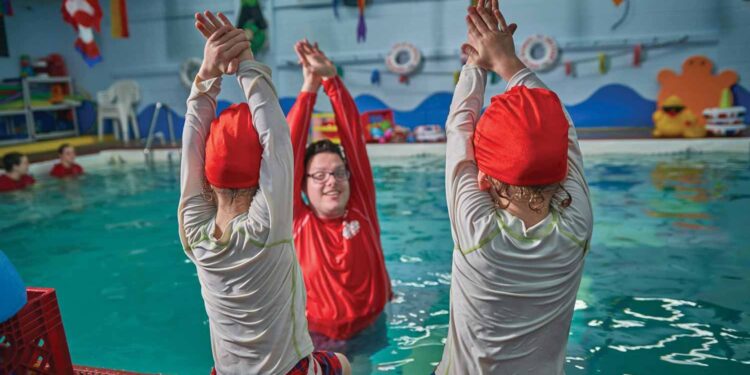Three industry experts share how to boost pool profits with basic aquatics programming.
Swimming pools, while popular, are no small investment for community rec facilities to undertake. Many operators have asked themselves, “How can aquatics programs generate revenue?” And for most facilities, it’s by sticking to the basics.
“I have found the best programs to generate money are well-organized swim lessons, both group and private lessons,” said Eric Hammermeister, the senior director of operations at the Shames JCC on the Hudson in Tarrytown, New York. “Aquatics exercise is starting to become more popular as well and has so many benefits many people are unaware of.”
The Shames JCC offers a variety of aquatics programs like lap swimming, swim lessons, self-led aquatics exercise, aqua cycle and aqua treadmills. Hammermeister said getting onboard with the latest trends is one of the best revenue generators for aquatics. “Some of the latest trends include but are not limited to Aqua Cycling classes, Aqua Boot Camp, Aqua Yoga, Aqua Pilates and using Aqua Boards,” he said.
While the upfront cost of the equipment required for some classes can be expensive, Hammermeister said if done properly all expenses can be returned and a profit started within the year. Properly marketing new programs and creating excitement around them is a great way to get members to participate.
Josh Reusser, an aquatics program manager for Salt Lake County Parks and Recreation, said while programs are a great way to bring in revenue, sometimes simply focusing on safety and cleanliness can be a huge driver for your facility.
“Swimming pools have a way of fulfilling the cliché adage, ‘If you build it, they will come,’” said Reusser. “Aquatics participation has long been a favorite pastime. Wherever there are pools, there are congregations of people. The best way to attract people to make return visits — and increase revenue — is to make sure they feel safe and welcome while swimming.”
A clean environment can help lend to that feeling of safety, which will keep members returning. In fact, a great key to survival is to offer robust swimming lessons. This not only establishes the pool as a community resource, but also helps increase the number of people with the skill set to utilize that resource and participate in future programming.
“When setting up a swimming lesson program, equity should be at the forefront of every member of the aquatics team,” said Reusser. “Besides being good for the bottom line, learning to swim is a critical life skill 80% of children in households making $50,000 or less do not have. Finding ways to reach that group of people will be critical in establishing your aquatics operations as a true community asset.”
Hammermeister agreed not only are lessons a vital program to offer, they are also the most justifiable.
“Swim lessons are the most sustainable as there’s always a high demand,” said Hammermeister. “The CDC states nearly 10 people die from unintentional drownings every day. Our goal as aquatics professionals should be to increase the number of swim lessons offered to reduce this statistic.”
Prior to the coronavirus pandemic, offering lessons was one of the programs that generated the most revenue for the Bernard Weinger JCC location of the JCC Chicago in Northbrook, Illinois. However, when the pandemic hit and the J was limited to what they could offer, privately renting out their pool to a local swim club became the top revenue driver.
“During the pandemic, we have expanded our aquatics facility’s rentals to offer more swim club hours as well as water polo and competitive master swim rentals,” said Megan Roth Abraham, the chief advancement officer for the Bernard Weinger J. “We have become more accessible to outside community use. We are so grateful to our swim club rentals and fitness members who continue to use our facilities in a safe and distanced way.”
Establishing yourself as a community asset, especially in times of need, and having strong ties with the patrons of the facility and other community partners is key to gaining revenue.
While new programs can be attractive to members, continually offering a clean and safe environment is what is going to keep them coming back and help boost pool profits.
“It can be quite overwhelming at times,” said Reusser. “I recommend starting with creating a clean, safe facility and working your way down the list. Once you get this nailed down, everything else will quickly and easily fall into place. Remind your managers this takes time, but have a plan to make your pool a community asset and profitable at the same time.”










